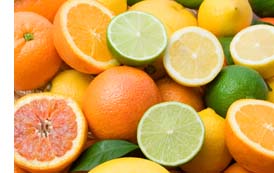Power Up with Citrus
- By Rebecca Taggart
- Reading Time: 4 mins.
 Once upon a time, back in the Victorian era, citrus fruits were rare and expensive, a delicacy to be enjoyed only on special occasions. Earlier still, for sailors suffering from scurvy on long voyages, limes or lemons literally could make the difference between life and death. Today, we take oranges, mandarins, grapefruits, lemons, and limes for granted, drinking their juice or eating their flesh without batting an eye. Now, as then, oranges and other citrus fruits are delicious snacks that deliver powerful nutrients and antioxidants and provide multiple health benefits, such as reducing the risk of some cancers, stroke, and cardiovascular disease.
Once upon a time, back in the Victorian era, citrus fruits were rare and expensive, a delicacy to be enjoyed only on special occasions. Earlier still, for sailors suffering from scurvy on long voyages, limes or lemons literally could make the difference between life and death. Today, we take oranges, mandarins, grapefruits, lemons, and limes for granted, drinking their juice or eating their flesh without batting an eye. Now, as then, oranges and other citrus fruits are delicious snacks that deliver powerful nutrients and antioxidants and provide multiple health benefits, such as reducing the risk of some cancers, stroke, and cardiovascular disease.
Citrus fruits contain fiber, folate, potassium, calcium, vitamins A and C, and many other nutrients, including carotenoids and flavonoids. A joint 2003 report by the World Health Organization and the U.N. Food and Agriculture Organization, as well as a 2003 report from Australia’s national science agency, found that regular fresh citrus consumption protects against a huge array of illnesses. For instance, it may reduce the risk of esophageal, mouth, and stomach cancers by 40 to 50 percent and the risk of stroke by nearly 20 percent.
Oranges are full of phytonutrients like flavonoids and carotenoids. These compounds are strong anti-oxidants and can fight against inflammation and tumors. One example, the flavonoid hesperidin, has strong anti-inflammatory properties and lowers high blood pressure and cholesterol in animal studies. It also has the potential for treating osteoporosis and is the subject of much ongoing research.
Want farm-fresh fruit?
We've got you covered.Real Vitamin C
Citrus fruits’ most well known component is vitamin C, one of the most widely consumed nutritional supplements in the U.S. Yet studies show that vitamin C in supplemental pill form does not have the same antioxidant effects as fresh citrus fruit or juice, likely due to complex interactions with the many other antioxidants available in citrus, as shown in a 2007 study published in the British Journal of Nutrition.
Vitamin C and other antioxidants protect our cells from damage by free radicals, which form in our body as a result of respiration and metabolism. Free radicals cause inflammation in the body, damage our DNA, and cause cholesterol to become “sticky” and adhere to the walls of arteries, leading to cardiovascular disease. Vitamin C also helps our immune system function properly. In fact, vitamin C is so critical to life that most animals can produce it themselves; humans can’t, however, so we have to consume it in our foods.
Another powerful antioxidant in citrus fruits is limonin. A potent anti-carcinogen, it remains in the body for up to 24 hours, which is four to six times longer than similar compounds from green tea remained in the body, according to a 2005 study by U.S. Department of Agriculture scientists. Limonin is mainly found in the zest, or outside peel, of citrus fruits. Zest can be obtained by grating the peel of a lemon or orange. Always wash fruit well in fresh cold water before grating, and choose organic fruit whenever possible to avoid pesticide residue.
Want farm-fresh fruit?
We've got you covered.Use and Storage
Citrus is winter fruit that grows in warm climates and then is shipped to colder zones. Most is harvested from November through May, but California’s Valencia orange is called a summer orange because its harvest runs from February to October. In the U.S., the biggest citrus growing areas include Florida (oranges, mandarins, grapefruit, lemons); Southern California (oranges, mandarins, grapefruit, lemons, and limes); southwestern Arizona (oranges, grapefruit); southern Texas (grapefruit); and southeastern Louisiana (satsumas). About 60 percent of U.S.-grown citrus comes from Florida, and much of that is made into juice.
Pick firm oranges without soft spots. An exception is the satsuma mandarin, which tends to have a puffy peel when it’s ready to eat. Ripe oranges may not be totally orange but could have a green tinge to them. Oranges that are grown in colder regions tend to be more orange, while oranges grown in hotter areas send green chlorophyll to their outer skin to protect from sunburn. Green oranges still taste sweet. Oranges can be stored at room temperature for about two weeks or refrigerated for up to several months.
A medium orange has only about 60 calories yet provides 116 percent of the Daily Value of vitamin C; 13 percent of dietary fiber; 10 percent folate; 8 percent vitamin B1; 7 percent potassium; 6 percent vitamin A; and 5 percent calcium.
Most citrus can be simply peeled and eaten out of hand or added to salads. The outer peel of the orange is both delicious and fragrant—try grating a little in your yogurt or salad, but be sure to wash the fruit first! To juice citrus, roll a room-temperature orange or lemon on the counter to soften it, then cut in half and juice. The pulp contains much of the fiber, so don’t strain it if you want all the health benefits citrus has to offer.
Want farm-fresh fruit?
We've got you covered.
Rebecca Taggart is a San Francisco–based yoga instructor


